The Anaesthesia Newsletter October 2021
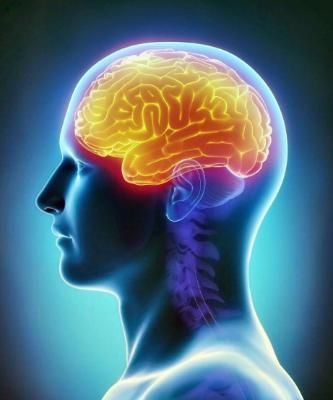
Standing on the shoulders of giants.
Dr Oonagh Hickey, Consultant Anaesthetist, CUH
On 9th September, Mr Michael O’Sullivan (Consultant Neurosurgeon) chaired a very special Grand Rounds at the CUH, celebrating 50 years of neurosurgery in Cork. In attendance were Mr Ted Buckley (Consultant Neurosurgeon) and Dr Seamus Harte (Consultant Anaesthetist) who, on the first Monday in June 1971, undertook the first neurosurgical procedure in Cork at St Finbarr’s Hospital. Various speakers outlined the past, current and future development of the neurosciences in Cork, including neurosurgery, neuroradiology, neurology and neuropathology. I had a personal interest as my father, Dr Matt Hickey, was the first neuroradiologist appointed to Cork- and the second in the country- in 1976.
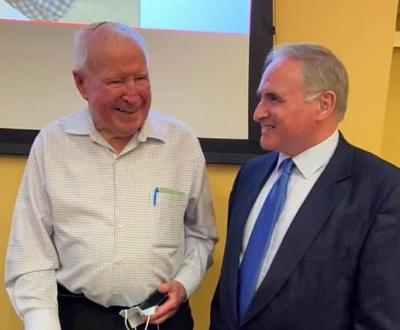
A common theme throughout was that the early pioneers in these specialties faced many challenges and often worked single-handed for many years. This is true for many of the services that we take for granted today. The various speakers also outlined the need for good teamwork with other specialities and disciplines when developing services. There was a particular mention of those who made great contributions to the development of the neurosciences in Cork and who have since passed away, including Dr Mary Lehane, Consultant Anaesthesiologist.
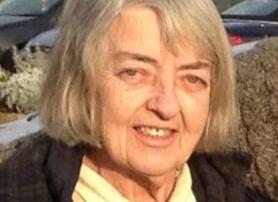
Anaesthesiologists play a vital role in the care of patients presenting with neuropathology- perioperatively, in the neuroradiological suite, and in the critical care setting. We enjoy a great working relationship with our neurosurgical colleagues, and Dr Niamh McAuliffe (Consultant Anaesthesiologist) was specifically credited at this meeting for her perioperative management of patients undergoing awake craniotomy. We are very grateful for her contribution on this topic in the Spotlight Section.
We extend our heartiest congratulations to Mr Ted Buckley, Dr Seamus Harte and to our neurosurgical colleagues on this very significant anniversary.
Photos- Mr Ted Buckley and Mr Michael O’Sullivan, credit- Ms Terri Goulding; Dr Mary Lehane.
Spotlight Section:
Awake Brain Surgery in Cork University Hospital
Dr Niamh McAuliffe, Consultant Anaesthetist, CUH
Brain tumours that are located in regions of the brain that control vision, movement or speech, sometimes require a specific surgery called an “Awake Craniotomy”. This can be a frightening prospect for those who have recently received such a significant diagnosis. The first thing we tell patients who are booked for an “Awake Craniotomy” is that they are not going to be awake for the whole operation as the name implies. The patient is first anaesthetised and we wake them for at the most sensitive point of the surgery. The surgeon asks specific questions, all the time stimulating the relevant part of the brain with electrodes to map a safe pathway for tumour removal. The aim is to optimise tumour removal whilst minimising risk of complications.
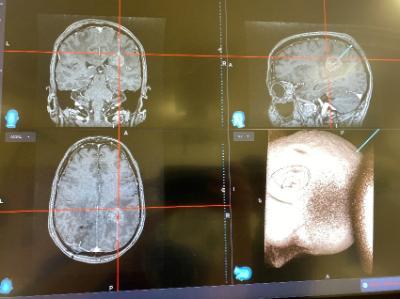
This process involves a large multidisciplinary team including neurosurgery, anaesthesia, neurophysiology, speech and language therapists, theatre nurses and theatre porters. Clear communication with the patient and within the team plays a key role throughout the procedure. Neurosurgery, anaesthesia and speech and language therapists all spend time with the patient preoperatively preparing them for the challenges ahead. Speech and Language Therapists assess speech patterns before the surgery and monitor the patient during the procedure to see if there is any change that may be significant. Dropped words or difficulty forming sentences all form part of the assessment in theatre and help the surgeon with intraoperative decisions. Patients often look up Dr Google before the operation and find videos of patients playing musical instruments during the procedure. This gives an insight into how awake and relaxed some patients can be while a surgeon is operating on their brain. Like the old ‘Doctor, Doctor’ joke, an existing ability to play the musical instrument in question would be advised before trying this!
One of the more challenging ingredients in the recipe is intraoperative assessment. One very simple but effective test involves the patient squeezing a squeaky duck and the auditory feedback can help the surgeon to assess the motor strength in the patients' hand while operating on the tumour. This function is also achieved by sophisticated neurophysiology monitoring but the duck is more photogenic!
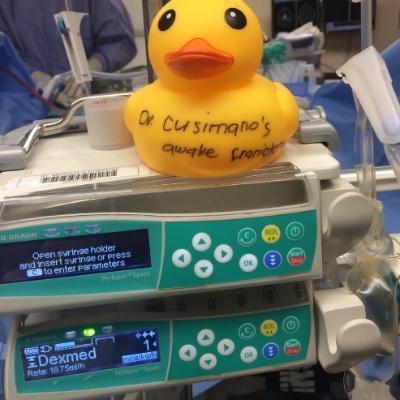
It is a fascinating process involving an extremely skilled multidisciplinary team and it is a privilege to be involved in this care pathway in Cork University Hospital.
October Blue Zone Challenge:
Dr Frank Loughnane, Consultant Anaesthetist, CUH
As the weather turns to Autumn /Winter I'd like to propose a health and well-being challenge for the month of October.
Some of you will be familiar with the Blue Zones, areas around the world where it is normal to live long healthy lives. Dan Buettner has researched these areas and distilled some of their essential ingredients so that the principles can be adopted on an individual, community and workplace basis.
The Blue Zone Life Challenge is a 4 week programme that can be undertaken at an individual or family level and is an excellent journey in its own right or an introduction to a greater life investment if you wish. There are real and measurable benefits to be had.
I'm hoping there will be enough interest in our department of 90 people in undertaking this challenge for 4 weeks in October. If so, it'd also be nice to collate our experiences over that period.
Other departments may be interested in developing similar initiatives, and we’d love to compare experiences.
Meet the team:
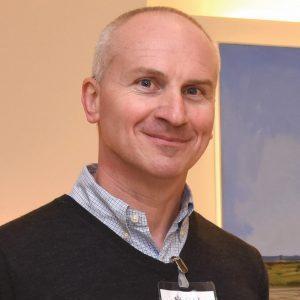
Dr Brian O’Brien, Consultant Anaesthesiologist and Chairman, CUH
-
What, or even who, lead you to choose anaesthesia as a career? Having always been interested in physiology, a lecture in 4th Med about the stress response to surgery completely fascinated me. I was interested from then. I got pretty sick during my internship (I went to theatre for a Whipples procedure, spent time in ICU post-op, and was out for over six months) and during that illness was very impressed by the logic and presence of Anaesthetists. At that point I didn’t expect to resume clinical work but knew that if I did, I would want a career in that area.
-
If you were to choose another medical speciality, what would it be? Medical statistics, or epidemiology - ideally with WHO, or some international level.
-
What book or film would you recommend to a young doctor? Tolstoy’s The Death of Ivan Ilyich - it tells you all you need to know about being a patient (and is very short).
-
Tell us something surprising about yourself? I play the piano a lot and as a student earned a small amount of money playing, during summers in the USA.
-
What would be your ideal weekend or holiday? Dingle for a weekend, South Africa for a holiday. Both are familiar to me, with great memories.
-
If you could go back five or ten years and give yourself advice, what would it be? Always question everything, in medicine nothing is fully known - so learn from your own observations. It’s more interesting than reading!
-
Is there anyone you regard as your idol or hero? The boy who appears at the end of The Emperor’s New Clothes (see answer 6!). It’s very hard to question a consensus.
-
What ability, gift, or even superpower, would you most like to have? I would love to be really good at swimming. I’m ok at it but would love to know how it feels to swim at Olympic - or thereabouts - level.
Academic updates:
17th World Congress of Anaesthesia 2021 Prague (virtual) Sept 1-5:
Dr Anil Ranganath presented three e-posters with abstracts published in the September Supplement of Anaesthesia & Analgesia
- Ranganath A, Ahmed O, Iohom G. Effects of local anaesthetic dilution on the characteristics of ultrasound guided axillary brachial plexus block: a randomised controlled study. Anesth Analg 2021; 133(S2): 1763-4
- Ranganath A, Iohom G. The effect of adding clonidine as an adjuvant to lidocaine with epinephrine for ultrasound guided axillary brachial plexus block. Anesth Analg 2021; 133(S2): 1765-6
- Ranganath A, Rauf J, Srinivasan K, Iohom G. Effect of lidocaine volume on the duration of axillary brachial plexus block: a randomised controlled trial. Anesth Analg 2021; 133(S2): 1761-2
Dr Gabriella Iohom conducted a Problem Based Learning Discussion session on the topic of anaesthesia for the fractured neck of femur
Prof George Shorten delivered a lecture entitled ‘Competency based education – the European Consensus Statement’.
EBPOM (Evidence based perioperative medicine) conference, Dingle Sept 21st-23rd:
Congratulations to the organisers, especially to Dr Jan Brohan (Consultant Anaesthesiologist, CUH), and to the presenters on an excellent conference.
For the first time, local Research in Pain Medicine was represented- with four excellent projects accepted for poster presentations. These covered diverse topics including the impact of the current pandemic on the delivery of Chronic Pain Services in Cork; factors associated with intern’s career choices with regards to anaesthesiology, intensive care and pain medicine; and management of acute piriformis syndrome in multi-morbid older adults.
Recent publications:
- Fahy C, O'Sullivan C, Iohom G. Clinician Monitoring. Anesthesiol Clin 2021; 39(3): 389-402.
- Roche D, Mahon P. Depth of anaesthesia monitoring. Anesthesiol Clin 2021; 39(3): 477-492.
- Iohom G, Joshi GP. Monitoring: Back to the Future. Anesthesiol Clin. 2021;39(3): xv-xvi
- Fodor D et al (Iohom G as part of the expert panel). The EFSUMB Guidelines and Recommendations for Musculoskeletal Ultrasound - Part I: Extraarticular Pathologies.
- Ultraschall Med 2021 Sep 3. doi: 10.1055/a-1562-1455. Online ahead of print.
- Mohamed H, McAuliffe N, O'Connor R, Ceballos Salazar A, Zohaib Aslam M, Kallidaikurichi Srinivasan K, Iohom G, Shorten G. Proficiency-based progression training: implementing a novel approach to training for epidural analgesia in labour. Int J Obstet Anesth. 2021 Aug 17;48:103213. doi: 10.1016/j.ijoa.2021.103213. Online ahead of print.
Dr Géraldine Armissoglio, Dr Paschalitsa Serchan and Dr Parvaiz Hafeez hosted Part I and the In-training Assessment of the European Diploma of Anaesthesiology and Intensive Care (EDAIC) at CUH on September 11 2021.
Congratulations to the following appointees to the role of Adjunct Clinical Lecturer at UCC for the academic year 2021-22; Murray Connolly, Laura Griseto, Emma May Lyons, Andrew Maxwell, Rebecca Monaghan, Eoin O’Rathallaigh, Paul Ryan, Paschalitsa Serchan.
Social events:
The CUH Hot Rods
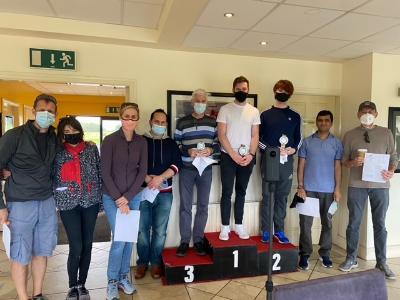
Dr Eoin O’Rathallaigh, SpR, CUH and co-editor
To cultivate extra-curricular interests that don’t involve running, cycling, or swimming, a small group of CUH adrenaline junkies took part in a hi-octane go-karting session on a sunny September afternoon in the Adventure Park at Watergrasshill. While the idea was to build upon the great teamwork that already exists in CUH Anaesthesiology, it was every driver for themselves in what was a great afternoon of speed records, fast corners, merciless overtaking, and some unplanned off-piste excursions.
Congratulations to Andrew Maxwell (1st place) and Fergus Walsh and his son Andrew who came in a close and respectable 2nd and 3rd. The afternoon certainly brought about some surprising (and some not-so-surprising) competitive spirit within the group. Unfortunately, there has to be a wooden spoon, in this case awarded to Eoin O Rathallaigh, who insisted that there must have been something wrong with his vehicle. (Editor [OH] note: Subsequent independent technical analysis revealed no defects - the consensus from the Department is that he would probably be faster running).
Good news:
The CUH Department of Anaesthesiology would like to congratulate Dr Valentina Pacher, Dr John O’Connell and Dr Ciaran Doherty on their recent weddings, and Dr Daniel Coffey on his recent engagement. We wish them and their respective spouses all the best in the future.
Cool Corkonians:
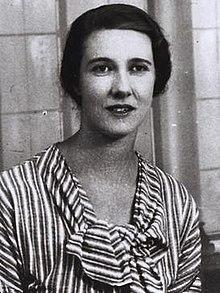
Mary Elmes (1908-2002)
It’s better to build a bridge than a wall:
Mary Elmes was born in Cork City in 1908. Like many of her generation, she grew up in a world full of conflict. As a child, she knitted socks for soldiers stationed in the trenches during WW1. Her parent’s pharmacy on Winthrop Street (where MacDonald’s is now) was burned down during the Burning of Cork by crown forces in 1920 in retaliation for a fatal ambush at Dillon’s Cross during the Irish War of Independence. When the Spanish Civil War broke out, she volunteered to help refugees- following them into France as Spain became too dangerous. Finding herself in France during World War 2, she helped over 400 Jewish children escape from certain death in the Auschwitz concentration camp, hiding many of them in the boot of her car. She was arrested in 1943 and spent six months in a notorious Gestapo prison near Paris. According to her son, her old prison blanket was a prized possession in later life.
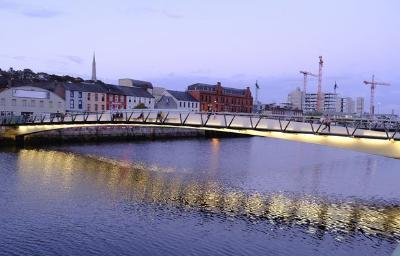
Mary Elmes was a humble person and rarely spoke of her humanitarian work after the war, refusing any awards offered during her lifetime. She died in 2002. In 2013, having been nominated by one of the children that she saved, she was recognised as “Righteous Amongst the Nations” by the State of Israel. A book about her life called “A Time To Risk All” was published in 2017. In 2019, a new pedestrian bridge named after her was opened in Cork City. Attendees included Charlotte Berger-Greneche, who was 4 years old when she was rescued by Mary Elmes. Her son Patrick Danjou was also present and part of his speech- “It’s better to build a bridge than a wall”- is proudly displayed on the wall of a building next to the bridge.
Editors:
Dr Eoin O’Rathallaigh, SpR, CUH, Dr Oonagh Hickey, Consultant Anaesthetist, CUH
Useful links:
